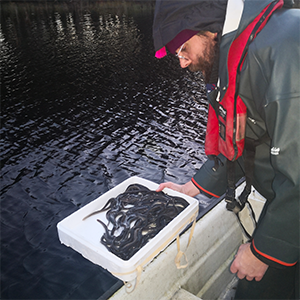Contact
Willem Dekker, Researcher
Department of Aquatic Resources, Institute of Freshwater Research, SLU
willem.dekker@slu.se, +46 10 478 42 48

The Swedish University of Agricultural Sciences now publishes its 4th evaluation of the Swedish eel status. While the 30-year downward trend has halted since 2011, the report advises to revise and update current management: protection of the eel is fine on the Swedish west coast, insufficient in inland waters, and unknown along the coast of the Baltic Sea.
Five researchers at the Department of Aquatic Sciences (SLU Aqua) present their fourth evaluation of the status of the eel stock in Swedish waters. Following the internationally-observed breakpoint in young eel abundance in 2011 (after 30 years of decline, now erratically going upward, but still a long way to go), the trend in all Swedish young eel time series is now also clearly upward.
On the west coast, the fishery was closed in 2012 – and since then, both the young eel (increasing recruitment) and the older eel (no longer beeing fished) show an increasing trend.
In inland waters, the combined impact of fisheries and hydropower-related mortality is high, exceeding the maximum mortality level as aimed for in the national Eel Management Plan (Ålförvaltningsplan AFP) and the EU Eel Regulation (2007). Thus, eels in the Swedish inland waters do not contribute to the recovery of the eel stock.
On the Baltic coast, the impact of the Swedish eel fisheries is small, but the status of the stock is unknown: those eels migrate between different countries, and the overview over all Baltic countries is still missing.
Based on these findings, the researchers advise to revise and update current management of the eel.
Willem Dekker, Researcher
Department of Aquatic Resources, Institute of Freshwater Research, SLU
willem.dekker@slu.se, +46 10 478 42 48